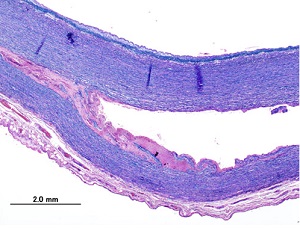Shared Content Block:
Surgery Styles -- "surgery-flex-gallery" class
Aortic Dissection Repair

Pathology slide of an aortic dissection. This damaged aorta was surgically removed and replaced by an artificial vessel.
Aortic dissection occurs when a small tear develops in the wall of the aorta. The tear forms an additional pathway for blood flow within that section of the aorta and causes the layers of the aorta to separate and weaken.
Aortic dissection is a serious condition. In some cases, the tear can extend through all layers of the aorta, resulting in massive blood loss and death.
Chronic high blood pressure, Marfan Syndrome, or atherosclerosis may increase your risk for aortic dissection.
Surgical treatment for aortic dissection involves the removal of the most severely damaged portion of aorta and replacement of the damaged section with a graft.
An alternative, minimally invasive approach is thoracic endovascular aorta repair. In this procedure, a stent graft is inserted via catheter inside the damaged portion of the aorta to strengthen it and prevent blood from flowing between the layers of the aortic wall.
Appointments and Information
This information is provided by the Department of Surgery at the University of Colorado School of Medicine. It is not intended to replace the medical advice of your doctor or healthcare provider. Please consult your healthcare provider for advice about a specific medical condition.